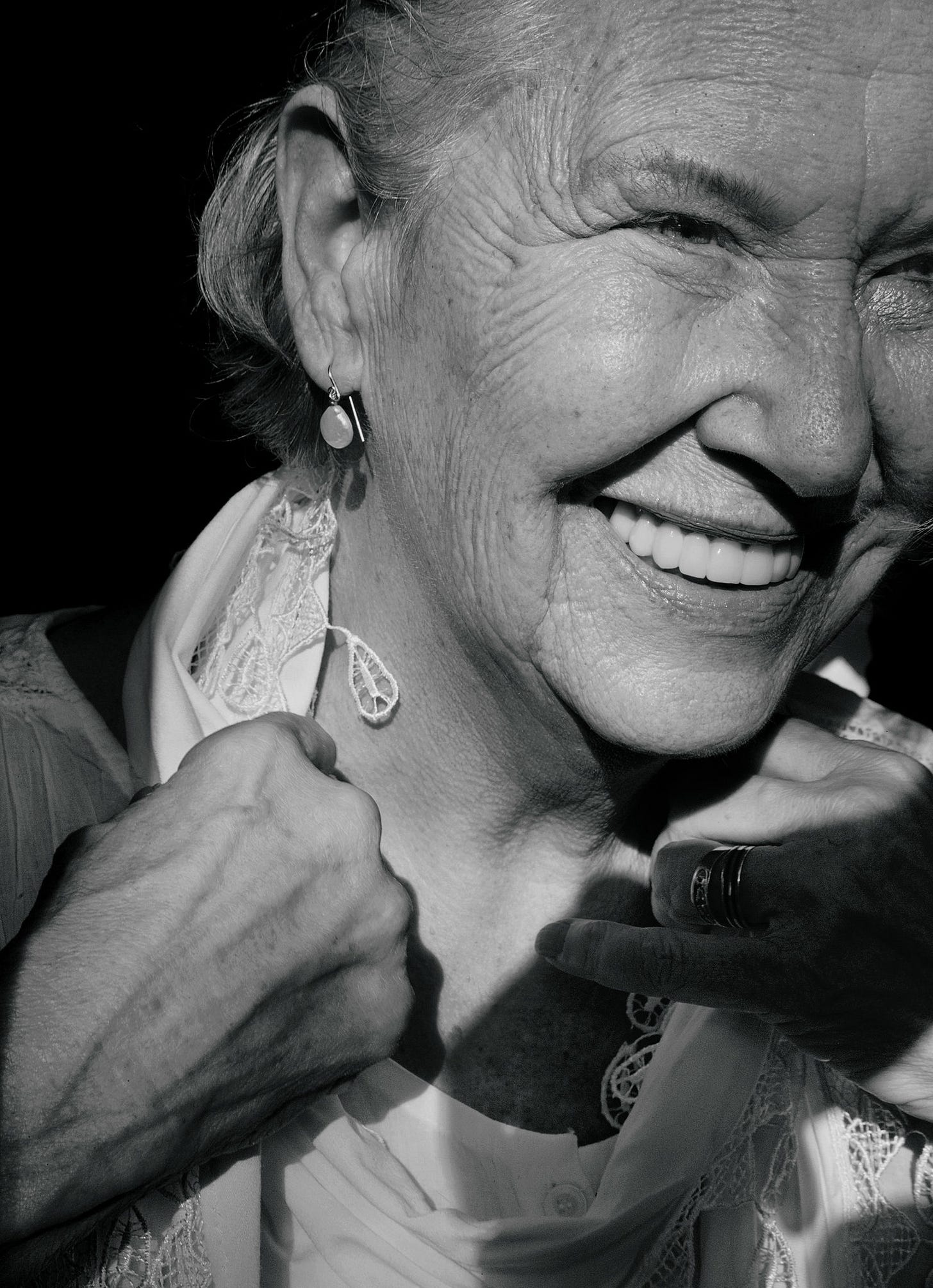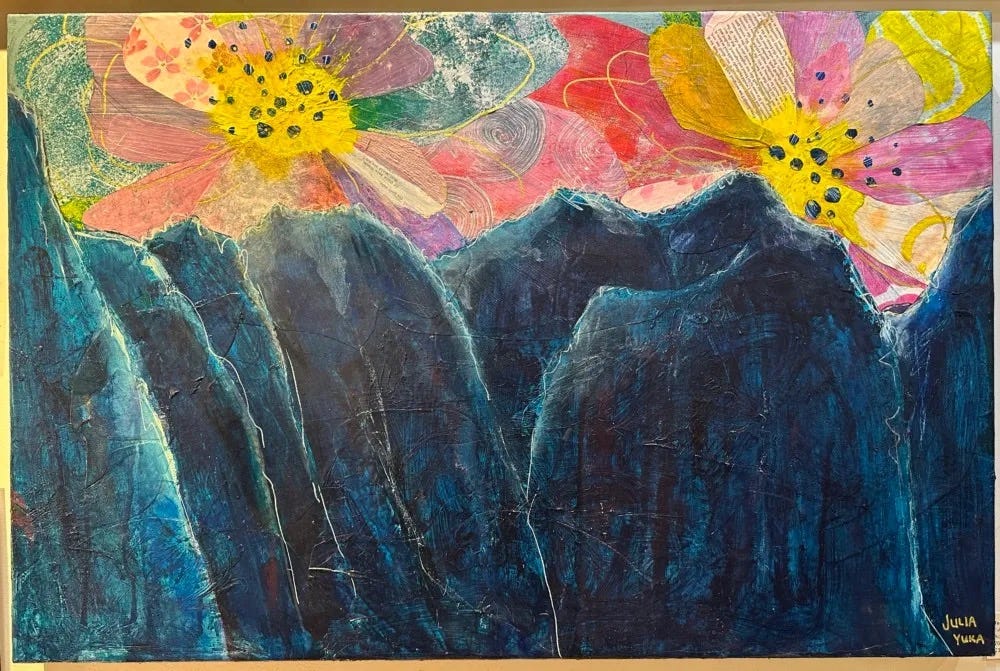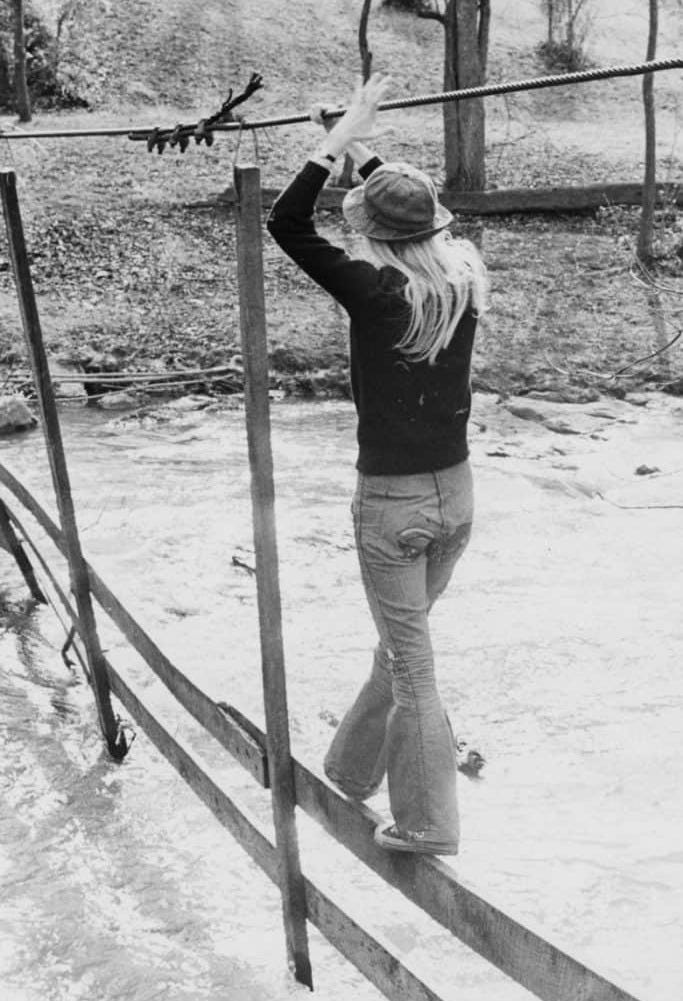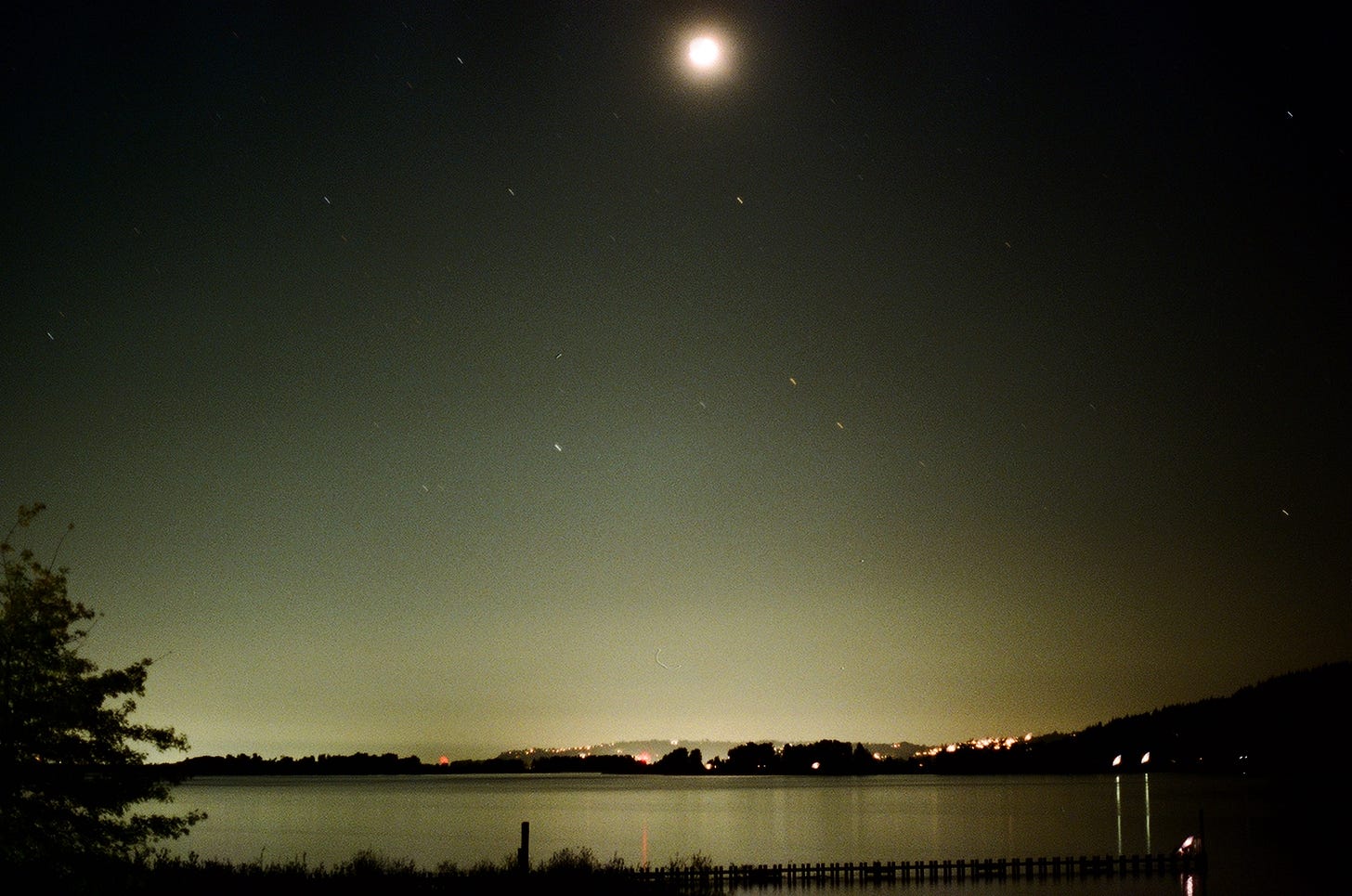Welcome to the first edition of UNIVERSAL RIVER VALLEY, a newsletter-platform-vehicle for sharing what I’m working on: collecting and disseminating symbols, myth, synchronicities, and subtler visions; for scribbling crooked diatribes, poetry disguised as research disguised as poetry, dreams spilled and worked awake. Glittery diary entries. Art and Movies I love. Inspirations I’ve gathered. Maybe some interviews with makers deeply admired?
I’m hoping to not merely use this as “a way of replacing instagram” but as a seed bed for many luscious creative elaborations—”academic” and creative writing, music, uncanny observations, microlectures, essayistic art-talk videos: maybe even some forms I haven’t thought of yet.
I’ll tell you about shows and emergent releases pertaining to my music project Half Shadow, as well as classes I’m teaching, readings I’ll be participating in, and more. Thank you for being here!
This month (June!) I’ll be leading something very special that I’ve been dreaming up: an Annie Dillard Readers Seminar through Literary Arts here in Portland, Ore. It starts on June 12th! These are more than glorified book clubs—but are also very much book clubs—in which we gather on a week night, sip white wine, and collectively ponder a freshly read slab of some beloved author’s text. They call these groups “delves” for a reason: we get in there and observe the garden, attention switched ON. We laugh and cry and share and read favored passages, and sometimes, when its really good we argue about the book—passions alit. I love that part.
Fates willing, this seminar, celebrating the undisputed queen of ecstatic nature writing—what we might call ecopoiesis—will be no less vibrant. We’ll start with Dillard’s early, and incredible Pulitzer-winning masterpiece Pilgrim at Tinker Creek, get lost with her in incandescent travel essays contained in Teaching a Stone to Talk, and close with—my personal favorite, and the namesake for this class—Holy The Firm, a brief but engrossing book length treatise questioning the living force of suffering. You can read the full class description here.
Annie Dillard feels like kin to me. Deeply spiritual, kinetic, salty and searing, tender and uncompromising, she has a way of forming language that mirrors the way I’ve come to sense the world: with a consciousness cognizant of veiled strata, psychic sediment, shades lurking in the root system. She seems to conjure the “natural world”—which for her includes weird clown art, various caged and tanked animals, ghostly apparitions amidst the trees, near-fatal plane crashes, ouroboric snake skins tangled amongst garbage-dump debris; time, weather, bugs, branches, and consciousness itself—in all of its mercy and shatteredness. She sees into it, as if capable of peering directly unto the enclaves of the world soul.
Whenever I witness her identifying something indelible, unkempt in the thicket of her paragraphs, I feel as thought the real world has been opened. As if she had uncovered a door in the wave of reality, snatched our wrist and dragged us through. As she writes in Pilgrim at Tinker Creek, part of her social mission consists in the blowing of minds
I have often noticed these things, which obsess me, neither bother nor impress other people even slightly. I am horribly apt to approach some innocent at a gathering and, like the ancient mariner, fix him with a wild, glitt’ring eye and say, “Do you know that in the head of the caterpillar of the ordinary goat moth there are two hundred twenty-eight separate muscles?” The poor wretch flees. I am not making chatter; I mean to change his life.1
To be gloriously accosted by her incandescent awareness, as with the frightened man at the party, is not always entirely pleasant. It’s meant to challenge us in psyche and soma. Like when she’s enumerating a dream of fishy rot and ooze in the chapter of Tinker Creek entitled “Fecundity” and meditating on pure, embodied disgust. Still it always plants some strange, sensate majesty in the heart.
“This looking business,” she quips, “is risky.”2 By risking with her, we get to enter something unfathomably cool—a space made outside of the artificial comfort many of us have come to be laminated within. She returns us to the boundlessness and blister of phenomena; its sloshed and ragged unfurling, its discomfort and unbearable beauty. We get to be freed, changed in the good, rough air.
Nowhere is this more evident to me than in the essay which inaugurates her collection Teaching a Stone to Talk, “Full Eclipse.” In the piece she and her partner trek from their coastal Washington home inland and into the Yakima Valley to be in the path of totality. They awake early in a motel, climb up on a grassy hill, and sit with others agape as the sun swallows the moon, bringing on what was for Dillard an uncanny, and terror-filled semi-darkness.
I turned back to the sun. It was going. The sun was going and the world was wrong. The grasses were wrong; they were platinum. Their every detail…artificially distinct as an art photographer’s platinum print. This color has never been seen on earth. The hues were metallic; their finish was matte…My hands were silver. All the distant hills’ grasses were finespun metal which the wind laid down. I was watching a faded color print of a movie filmed in the Middle Ages….I looked at Gary. He was in the film. Everything was lost….I saw on his skull the darkness of night mixed with the colors of day…[he] was lightyears away, gesturing inside a circle of darkness.3
Then, the eclipse becomes total, and at that moment she writes, “From all the hills came screams.”4 The holy horror of this moment, its psychedelic disorientation, and Dillard’s incredible way of painting the image in sheer, shocking, ”matte platinum” (my god what a phrase, what an image!) is like being thrust into a deeply unsettling dream. We are baked into it, blued. She viscerally accomplishes her task of saying something so startling about the cosmos; landscape; reality; that we realize she truly is not “making chatter” but reporting her own real, subtle vision of substance drawn finely: tangible vision gathered and translated into lucid, ever-bearing text.
It’s hard (for me, anyway) to sup this passage without the room beginning to spin; it is literally psychoactive. And I think this is why we read Dillard. Her mind, her vision—like a seer, a psychopomp, leads us into the real wild—that place where human experience meets the thing we refer to as “nature,” imagining that it’s outside of us—an alien environment. It is not. We are it, it us. As one of my favorite Mount Eerie songs explains “because the pupil of my eye is a hole / there’s no inside and no out / the world is in me and I am in the world.”5
It’s not all dread and swamp though, in these books. Dillard also scribes the ebullience and grace of her landscapes wandered, as well. She writes of the “wind thinned to the delicate air of twilight; it crumples the water’s skin”6 and how she “would like to know grasses and sedges—and care.”7 This is pure tenderness. Or she spins incandescent lines of poetry that leave the heart glimmer’d. “The secret of seeing is to sail on solar wind.”8 These are just a few brief examples.
To abide with her means to access a state of feral awe, and to stay there. Presence is her game, and her gift. “Experiencing the present purely,” she writes “is being emptied and hollow, you catch grace as a man fills his cup under a waterfall.”9 When we’re with Dillard, our vessels runneth over.
SIGN UP FOR ANNIE DILLARD: HOLY THE FIRM
If any of this sparks something in you and you have the time, come join us at Literary Arts for Annie Dillard: Holy the Firm. It runs from June 12th to July 24th on Thursdays from 6:00-8:00 p.m. (six sessions, no meeting July 3).
I realize the cost of the class might be prohibitive for some people, but Literary Arts offers an “access program” for those who cannot swing it, but would still like to come. You can apply for access tuition via the class listing.
Lately I’m listening to Hana Stretton’s Soon (in the gloaming) and Eddie Marcon’s Yahho no Potori amongst other soft-listens; eating adaptogenic, chocolate-oatmeal lactation cookies (we just had a baby), moving box fans into different windows as the spring heats up in the pacific northwest, and trying to regulate my nervous system as often as I can. Sauna helps.
Talk to you soon.
Kindly, Jesse
Dillard, Annie. Pilgrim at Tinker Creek. Harper & Row, 1988. pg. 132
Dillard, Annie. Pilgrim at Tinker Creek. Harper & Row, 1988. pg. 23
Dillard, Annie. “Total Eclipse,” Teaching a Stone to Talk. Harper Perrenial, 1982. pg. 16
Dillard, Annie. “Total Eclipse,” Teaching a Stone to Talk. Harper Perrenial, 1982. pg. 17
Mount Eerie. “No Inside, No Out.” No Flashlight. P.W. Elverum & Sun, 2005/2015.
Dillard, Annie. Pilgrim at Tinker Creek. Harper & Row, 1988. pg. 13
Dillard, Annie. Pilgrim at Tinker Creek. Harper & Row, 1988. pg. 15
Dillard, Annie. Pilgrim at Tinker Creek. Harper & Row, 1988. pg. 33
Dillard, Annie. Pilgrim at Tinker Creek. Harper & Row, 1988. pg. 81
Hi I’m Jesse Carsten (they/he), an artist, writer, musician, and mythologist living in Portland, Oregon. My creative work and thought centralizes mystery, generative beauty, individual and ecological grief, poetics as a living force, and the psychology of personal myth. I’ve have been composing music under the Half Shadow moniker for more than a decade. Salt, a book of my experimental prose poems and B. Ingrid Olsen’s photographic images was published by Hassla Press in 2017. I’m currently working on new music, several zines and a chapbook, building furniture out of wood, teaching classes, and partaking in the challenging ecstasies of family life.










